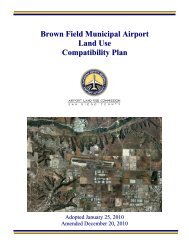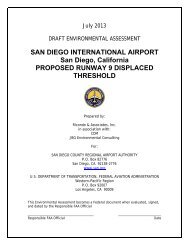MCAS Miramar Airport Land Use Compatibility Plan - San Diego ...
MCAS Miramar Airport Land Use Compatibility Plan - San Diego ...
MCAS Miramar Airport Land Use Compatibility Plan - San Diego ...
You also want an ePaper? Increase the reach of your titles
YUMPU automatically turns print PDFs into web optimized ePapers that Google loves.
CHAPTER 1INTRODUCTIONwith the local agencies. In one particular respect, this coordination is mandatory. State lawrequires "hearing and consultation with the involved agencies" with regard to establishment ofAIA boundaries. (Pub. Util. Code, §21675(c).)Another aspect of the relationship between the ALUC and local agencies concernsimplementation of the <strong>Compatibility</strong> <strong>Plan</strong>. Although the ALUC has the sole authority to adoptthis <strong>Compatibility</strong> <strong>Plan</strong> and to conduct compatibility reviews, the authority and responsibility forimplementing the compatibility policies rests with the local agencies that control land uses withinthe AIA. Actions that these local agencies can take to implement the <strong>Compatibility</strong> <strong>Plan</strong>'s policiesare outlined later in this chapter.1.2 POLICY FRAMEWORKThe policies in Chapter 2 and 3 of this <strong>Compatibility</strong> <strong>Plan</strong> are based upon these primary sources:the Aeronautics Act and other state laws and guidelines, including those in the California <strong>Airport</strong><strong>Land</strong> <strong>Use</strong> <strong>Plan</strong>ning Handbook (Handbook) published by the California Department ofTransportation, Division of Aeronautics (Division of Aeronautics); and the <strong>MCAS</strong> <strong>Miramar</strong> AICUZ,dated December 2004, and revised March 2005.1.2.1 State Laws and GuidelinesMany of the procedures that govern how ALUCs operate are defined by state law. Statutoryprovisions in the Public Utilities Code require ALUC adoption of compatibility plans for eachpublic use and military airport, and establish certain steps to be taken in the plan adoptionprocess. (See Pub. Util. Code, §21675.) The law also dictates the requirements for airport landuse compatibility reviews by the ALUC and the types of actions that local agencies must submitfor a consistency review. (See, e.g., Pub. Util. Code, §§21675.2, 21676, 21676.5.)When preparing compatibility plans for individual airports, ALUCs must be guided by theinformation contained in the Handbook. The Handbook is not regulatory in nature, however, andit does not constitute formal state policy except to the extent that it explicitly refers to statelaws. Rather, its guidance is intended to serve as the starting point for compatibility planningaround individual airports. The policies and maps in this <strong>Compatibility</strong> <strong>Plan</strong> take into account theguidance provided in the current edition of the Handbook, dated January 2002.An additional function of the Handbook is established elsewhere in California state law. ThePublic Resources Code creates a tie between the Handbook and California EnvironmentalQuality Act (CEQA) documents. Specifically, Public Resources Code section 21096 requiresthat lead agencies use the Handbook as "a technical resource" when assessing airport-relatednoise and safety impacts of projects located in the vicinity of airports.The Handbook is available from the Division of Aeronautics.1.2.2 Relationship to AICUZ StudiesFederal regulations require the military services to prepare an AICUZ study for each militaryairfield. The AICUZ Program was established by the Department of Defense (DOD) inresponse to increasing incompatible urban development around military airfields. DODInstruction Number 4165.57 (November 8, 1977) (Basic Instruction) provides the overall1–4 <strong>MCAS</strong> <strong>Miramar</strong> <strong>Airport</strong> <strong>Land</strong> <strong>Use</strong> <strong>Compatibility</strong> <strong>Plan</strong> (Adopted October 2008)
















